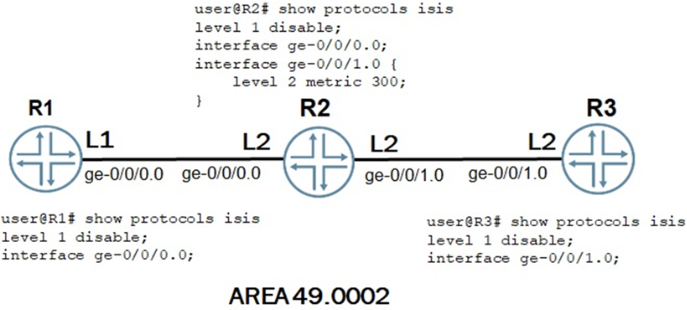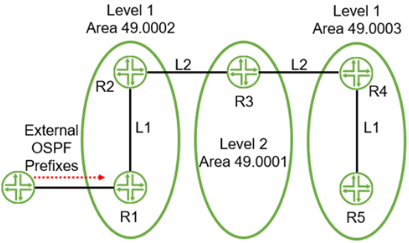01. Referring to the exhibit, what will the IS-IS cost be for R3 to reach R1?
a) 20
b) 310
c) 73
d) 301
02. Which two statements are true regarding route redistribution in IS-IS?
(Choose two.)
a) export policies can block internal and external routes from being advertised to neighbors
b) redistributing routes from different protocols can cause loops
c) export policies can block external routes from being advertised, but cannot block internal routes from being advertised
d) route properties in LSP advertisements prevent loops when redistributing routes from different protocols
03. Referring to the exhibit, external OSPF prefixes are being received by R1. R1 is exporting these prefixes into IS-IS. These prefixes must appear on R5 as IS-IS routes. Which action will produce this result?
a) Turn on wide metrics on R4 and R5 and write an export policy on R2 from level 1 to level 2 matching the prefixes from OSPF.
b) Write an export policy on R2 from level 1 to level 2 matching the OSPF prefixes.
c) Turn on wide metrics on R1 and R2 and write an export policy on R4 from level 2 to level 1 matching the prefixes from OSPF.
d) Write an export policy on R3 from level 2 to level 1 matching the OSPF prefixes.
04. What occurs when a router running IS-IS receives an LSP with the overload bit set?
a) The LSP is ignored during SPF calculation.
b) The LSP's metric will be set to 65535.
c) The LSP is not added to the link-state database.
d) The LSP's metric will be set to 16777215.
05. Which two BGP communities are pre-defined well- known communities?
(Choose two.)
a) public
b) private
c) no-export
d) no-advertise
06. You are responsible for configuring CoS for your network. Your network includes a video application with strict latency requirements, so that any packets delayed by more than 75 ms are effectively useless. You want to ensure that you do not waste buffer space. In this scenario, when configuring the scheduler for this application, which feature would you use?
a) exact
b) temporal
c) rate limit
d) remainder
07. You are configuring an OSPF network that contains 1G, 10G, and 40G links. You want the metric of each link to be automatically calculated based on the link bandwidth so that higher-speed links are a lower cost than lower-speed links. Which statement is true?
a) Configure the "reference-bandwidth" under the "protocols ospf" hierarchy.
b) Configure the priority on each interface within each protocol ospf area.
c) Configure the metric on each interface to match the link speed.
d) The default operation of OSPF will assign a lower metric to the 40G links.
08. Which two statements are true regarding traffic classifiers?
(Choose two.)
a) MF classification is performed before BA classification.
b) If both classifiers match, the first classifier overrides the last classifier.
c) If both classifiers match, the last classifier overrides the first classifier.
d) BA classification is performed before MF classification.
09. You have configured a Layer 3 VPN. The customer has two sites that connect to the same PE device. They want routes to be shared between those sites. Which two options will solve this problem?
(Choose two.)
a) User rib-groups to share routes between routing instances.
b) Place the interfaces to both sites within the same VRF.
c) Configure the same "vrf-target" for both sites.
d) Use "auto-export" on the PE.
10. Which two statements are correct regarding VPLS flooding?
(Choose two.)
a) BUM traffic that arrives from a local CE is flooded to remote PEs.
b) BUM traffic that arrives from a local CE is flooded to all local CEs except for the one that received the BUM traffic.
c) BUM traffic that arrives from a remote PE is flooded to all PEs and CES.
d) BUM traffic that arrives from a remote PE is only flooded to remote PES.
 Before you write the Juniper JNCIP Service Provider (JN0-664) certification exam, you may have certain doubts in your mind regarding the pattern of the test, the types of questions asked in it, the difficulty level of the questions and time required to complete the questions. These Juniper Networks Certified Professional Service Provider Routing and Switching (JNCIP-SP) sample questions and demo exam help you in removing these doubts and prepare you to take the test.
Before you write the Juniper JNCIP Service Provider (JN0-664) certification exam, you may have certain doubts in your mind regarding the pattern of the test, the types of questions asked in it, the difficulty level of the questions and time required to complete the questions. These Juniper Networks Certified Professional Service Provider Routing and Switching (JNCIP-SP) sample questions and demo exam help you in removing these doubts and prepare you to take the test.

